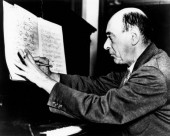Schoenberg began violin lessons when he was eight and almost immediately started composing, though he had no formal training until he was in his late teens, when Zemlinsky became his teacher and friend (in 1910 he married Zemlinsky's sister). His first acknowledged works date from the turn of the century and include the string sextet Verklärte Nacht as well as some songs, all showing influences from Brahms, Wagner and Wolf. In 1901-3 he was in Berlin as a cabaret musician and teacher, and there he wrote the symphonic poem Pelleas und Melisande, pressing the Straussian model towards denser thematic argument and contrapuntal richness. He then returned to Vienna and began taking private pupils, Berg and Webern being among the first. He also moved rapidly forwards in his musical style.
When atonality arrived, therefore, as it did in 1908, it came as the inevitable outcome of a doomed attempt to accommodate ever more disruptive material. However, Schöenberg found it possible a quarter-century later to return to something like his tonal style in such works as the Suite in G for strings, the completion of the Chamber Symphony no.2 and the Theme and Variations for band.
That, however, was not possible immediately. The sense of key was left behind as Schöenberg set poems by Stefan George in the last two movements of String Quartet no.2 and in the cycle Das Buch der hängenden Gärten, and for the next few years he lived in the new, rarefied musical air. With tonality had gone thematicism and rhythmic constraint; works tended to be short statements of a single extreme musical state, justifying the term 'expressionist' (Five Orchestral Pieces; Three Pieces and Six Little Pieces for piano).
Gradually Schöenberg came to find the means for writing longer instrumental structures, in the 12-note serial method, and in the 1920s he retumed to standard forms and genres, notably in the Suite for piano, String Quartet no.3, Orchestral Variations and several choral pieces. He also founded the Society for Private Musical Performances (1919-21), involving his pupils in the presentation of new music under favourable conditions. In 1923 his wife died (he remarried the next year), and in 1925 he moved to Berlin to take a master class at the Prussian Academy of Arts. While there he wrote much of his unfinished opera Moses und Aron which is concerned with the impossibility of communicating truth without some distortion in the telling: it was a vehement confrontation with despair on the part of a composer who insisted on the highest standards of artistic honesty.
In 1933 he was obliged as a Jew to leave Berlin: he went to Paris, and formally returned to the faith which he had deserted for Lutheranism in 1898. Later the same year he arrived in the USA, and he settled in Los Angeles in 1934. It was there that he returned to tonal composition, while developing serialism to make possible the more complex structures of the Violin Concerto and the String Quartet no.4. In 1936 he began teaching at UCLA and his output dwindled. After a heart attack in 1945, however, he gave up teaching and made some return to expressionism (A Survivor from Warsaw, String Trio), as well as writing religious choruses.
Excerpt from The Piano Concerto Op.42. Mitsuko Uchida, soloist. Rotterdams Philharmonisch Orkest, conducted by Jeffrey Tate. Score available at www.schoenbergmusic.com.
